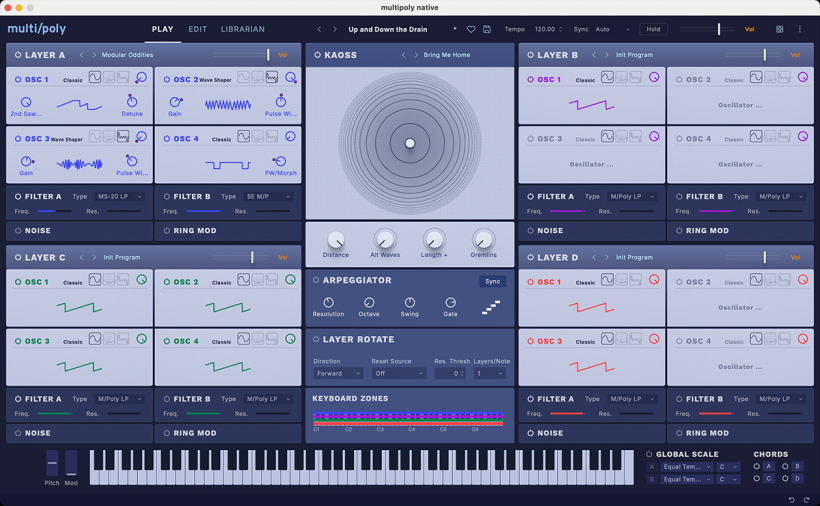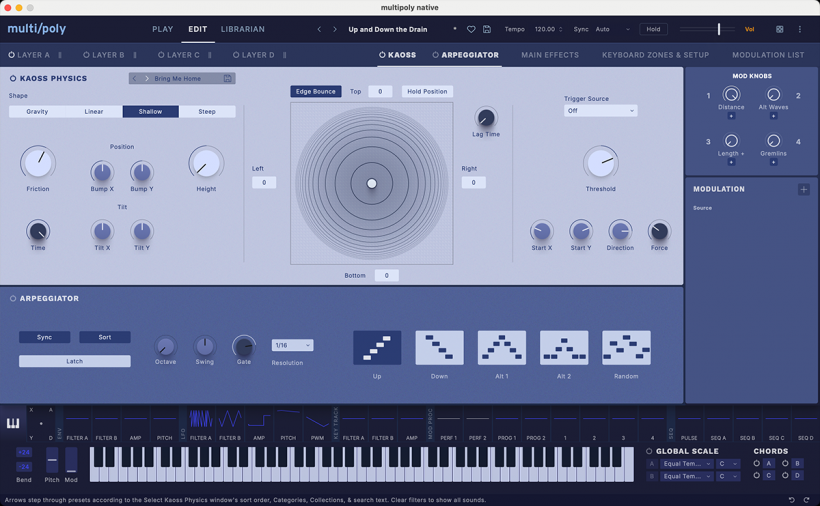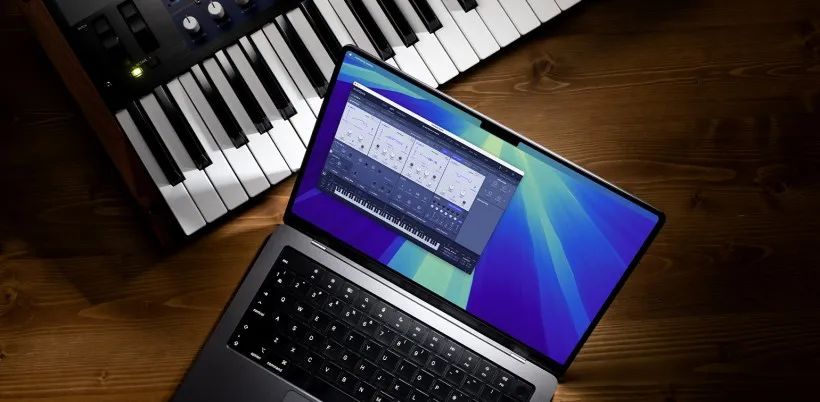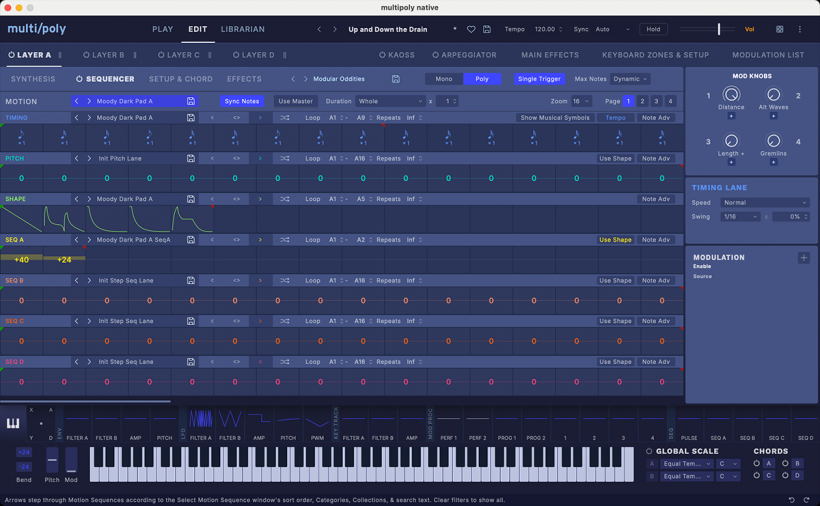Korg has announced the release of Multi/Poly Native, the software version of the Multi/Poly synthesizer. Users can seamlessly exchange sounds between hardware and software, accessing an ever-growing library of excellent third-party sounds while keeping their sounds and software updated. You can create with Multi/Poly Native in your DAW and then perform the same sounds on stage using the Multi/Poly hardware. Create sounds through the intuitive interface of the hardware and share them with your computer-based partners.
Multi/Poly
Multi/Poly is the first instrument to utilize KORG’s next-generation analog modeling technology, building on the legendary unique combination of big sound and modular-derived experimental features. It acts like a compact, intuitive polyphonic modular system — an endless playground for synthesizer players and sound designers, allowing you to create hardware hybrids using East Coast, West Coast, and wavetable oscillators along with a range of newly modeled filters.Different models of envelopes, VCAs, and glide circuits bring them to life, while virtual sound cards produce organic tonal variations, Layer Rotate triggers new programs with each key press, and rich features like Kaoss Physics, Motion Sequencing 2.0, and extensive modulation are included.
Advanced Analog Modeling
Multi/Poly features redesigned, high-quality filters and oscillators, but the advancements in analog modeling go far beyond that. Each sound has a virtual sound card, with oscillators, filters, envelopes, low-frequency oscillators, and glide circuits simulating the variations of analog hardware components. The result is that each sound has slightly different characteristics, creating naturally rich tones. Users can adjust the degree of this variation for each sound individually.Just like in analog synthesizers, even when the sound card is not audible, they continue to play. Envelopes evolve continuously, so if you play a Pad sound with a long release time, new notes will “capture” the current level of the envelope instead of starting from zero. The oscillators and low-frequency oscillators maintain their phase, and resonance continues to ring. The pitch of each oscillator also drifts slightly over time, simulating the slight pitch instability found in analog hardware.Envelopes are often an overlooked factor that contributes to the unique tones of vintage synthesizers. Multi/Poly includes envelope curvature presets from Mono/Poly, MS-20, Mini, Pro, ARP Odyssey, and more. Additionally, analog VCA responses to voltage are uneven, with different opening and closing thresholds, which significantly affects the characteristics of the amplified envelope. Thus, Multi/Poly simulates the VCA responses of Mono/Poly, MS-20, Mini, Odyssey, and Pro, along with linear options.
Oscillators
Each program in Multi/Poly provides four oscillators for exceptionally thick, complex tones. Each oscillator can use classic, digital, or waveform shaper oscillator types. Classic oscillators simulate traditional analog synthesizer oscillators with stunning fidelity and effortless thickness. There are 11 options, including single and dual waveforms for simulating synthesizers that generate multiple waveforms simultaneously. The front panel knobs allow you to manually control pulse width, triangle “tilt,” dual waveform mixing, and more.Digital oscillators play up to 64-step wavetables, reminiscent of vintage hybrid synthesizers and modern Eurorack modules. Starting with over 200 factory wavetables, you can also load your own wavetables — directly importing modwave wavetables or converting wavetables from popular software formats. Users can utilize over 30 modifiers to alter the way wavetables are loaded, producing tonal variations from subtle to extreme, and use 8 types of morphing (such as stretching, flipping, and mirroring) to process them in real-time.Waveform shapers provide a “West Coast” approach, where simple waveforms (sine or triangle) are processed through shaping tables. Modulating gain into the shaper produces glassy, dynamic harmonics. Use the Berkeley shaper for traditional waveform folding tones, or choose from over 90 other shaper types. Multi/Poly also adds adjustable pulse width, a unique twist that adds another dimension of richness and movement.
Dual Analog Filters
All filters in Multi/Poly have been redesigned, including a stunning set of vintage filters with authentic, pleasing saturation.First, there are five different 4-pole self-resonating models:
- M/Poly offers the powerful, sweet sound of the classic Korg Mono/Poly.
- Mini features a ladder filter from a beloved American monophonic synthesizer; resonance decreases at low frequencies, which is crucial for producing those classic bass sounds.
- Pro comes from the first programmable polyphonic synthesizer, with strong resonance sweeps all the way through.
- Ladder HP and BP are 4-pole self-resonating high-pass and band-pass filters, respectively.
- MS-20 LP and HP 12dB/octave self-resonating Korg 35 filters meticulously recreate the unique, aggressive tonal characteristics of the classic Korg MS-20.
- SE M/P 2-pole filter characteristics are more gentle and feature continuous control, allowing for sweeping between low-pass, band-stop, and high-pass, plus a standalone band-pass mode.
Users can also shape and refine tones using a full set of linear, resonant 2-pole and 4-pole low-pass, high-pass, band-pass, and band-stop filters. Alternatively, use KORG’s unique Multi Filter to break out of convention, creating a modulated mix of multiple modes simultaneously.
Multi/Poly Structure
Each program starts with four oscillators plus a noise generator, ring modulator, sync, and cross modulation. These signals are processed through two independent filters and modulated using four looping DAHDSR envelopes, five low-frequency oscillators, and six modulation processors. Users can add complex sound movements using multi-channel Motion Sequencing 2.0 and polish with three studio-quality insert effects.But this is just the functionality of one program; up to four programs can be layered in a Performance, allowing users to switch between them in a rotating manner using Layer Rotate, playable directly or driven by an arpeggiator. Create smooth, evolving modulation using Kaoss Physics from simple gestures on a touchpad or mouse. Intuitively control multiple low-level parameters with four modulation knobs, and use two additional modulation processors, main reverb, and EQ for final polishing.
Layer Rotate
Multi/Poly has four layers, each containing a program. Naturally, these can create layered sounds, velocity splits, and keyboard splits. Inspired by the sub-oscillator mode of the original Mono/Poly, Layer Rotate adds a new possibility: flexible rotation of entire programs.Users can set four layers to have different programs and cycle through them with each key press, playing them in repeated or random order. Trigger one, two, or three programs at each step of the cycle. Use Layer Rotate with the arpeggiator for mind-bending musical segments.
Modulation and Control
Multi/Poly offers a wealth of modulation sources and targets. Most parameters can be modulated, with over a thousand modulation targets per Performance, and there is no fixed limit to the total number of modulation routings, even allowing modulation of individual Motion Sequence step settings. Each modulation routing includes a primary modulation source, an intensity, and a secondary modulation source; the three multiply to create the modulation amount. A single target, such as filter cutoff frequency, can have up to 31 incoming modulation routings.Modulation knobs place macro transformations at your fingertips, making it easy to explore the sonic world of each performance. Users can quickly identify modulation sources with real-time displays of all envelopes, LFOs, and other primary modulation sources, and easily create modulation routings using drag-and-drop, gaining an overview of all routings through the modulation list.
Motion Sequencing 2.0
Motion Sequencing 2.0 evolves from Wavestate’s Wave Sequencing 2.0. Time, pitch, shape, and four sets of step sequence values are separated into “channels,” each with its own loop start and loop end, adding deeper, more customizable phrases and modulation recording.
Kaoss Physics
Kaoss Physics simulates a ball rolling on a surface and/or bouncing off walls. “Throwing” the ball is done through gestures on the mouse or touchpad, or using trigger sources (like threshold + damper) to automatically start the ball, and you can also directly control the ball by dragging without releasing.Users can record gestures and direct control using DAW automation. The ball’s position generates eight modulation signals that can be used to control any modulation target: X and Y position, distance from center, angle relative to the X-axis, and finally separate signals for +/- X and +/- Y. The result is an interactive controller that amplifies your physical gestures, transforming them into captivating, complex, and ever-changing musical outcomes.
Plug-and-Play Effects
Each layer has three dedicated effects processors, plus a main reverb send, followed by main parameter EQ. In addition to standard effects like compressors, EQs, choruses, flangers, phasers, and stereo delays, the synthesizer offers some unique effects processors like waveform shapers, voice modulators, reverse delays, multi-band modulation delays, and Overb (from OASYS and Kronos), as well as analog effects including VOX guitar amplifiers, VOX wah, vintage distortion, CX-3 rotary speakers, and tremolo/chorus, multi-head tape echo, and a range of classic guitar pedals.
Inspiration through Randomization
Looking for more inspiration? The “dice” icon at the top of the window generates new sounds through intelligent randomization. Randomize the entire sound or just parts of it, such as oscillators, filters, or effects. Use the randomly generated results directly or as a starting point for your own creations.
Upgrade Offer for Hardware Multi/Poly Users
Owners of the hardware Multi/Poly can purchase the Multi/Poly Native software at a special price of $49.99 by binding to the unique ID of the Multi/Poly hardware to obtain a coupon. Using both the hardware and software versions allows for the best of both worlds: a physical instrument that responds to touch and complete DAW integration.Official Website:https://www.korg.com/hken/products/software/multipoly_native/♬ ♯ ♩ ♪ ♫ ♬ ♭♬ ♯ ♩ ♪ ♫ ♭♬ ♯ ♩ ♪